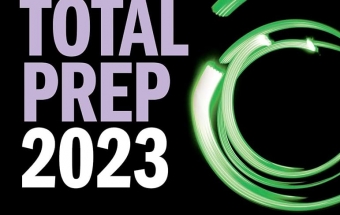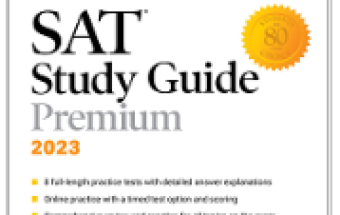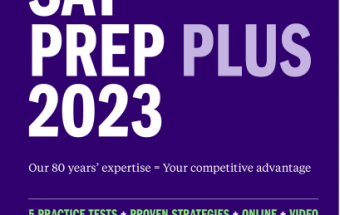SAT® Total Prep 2023 - Reading Test
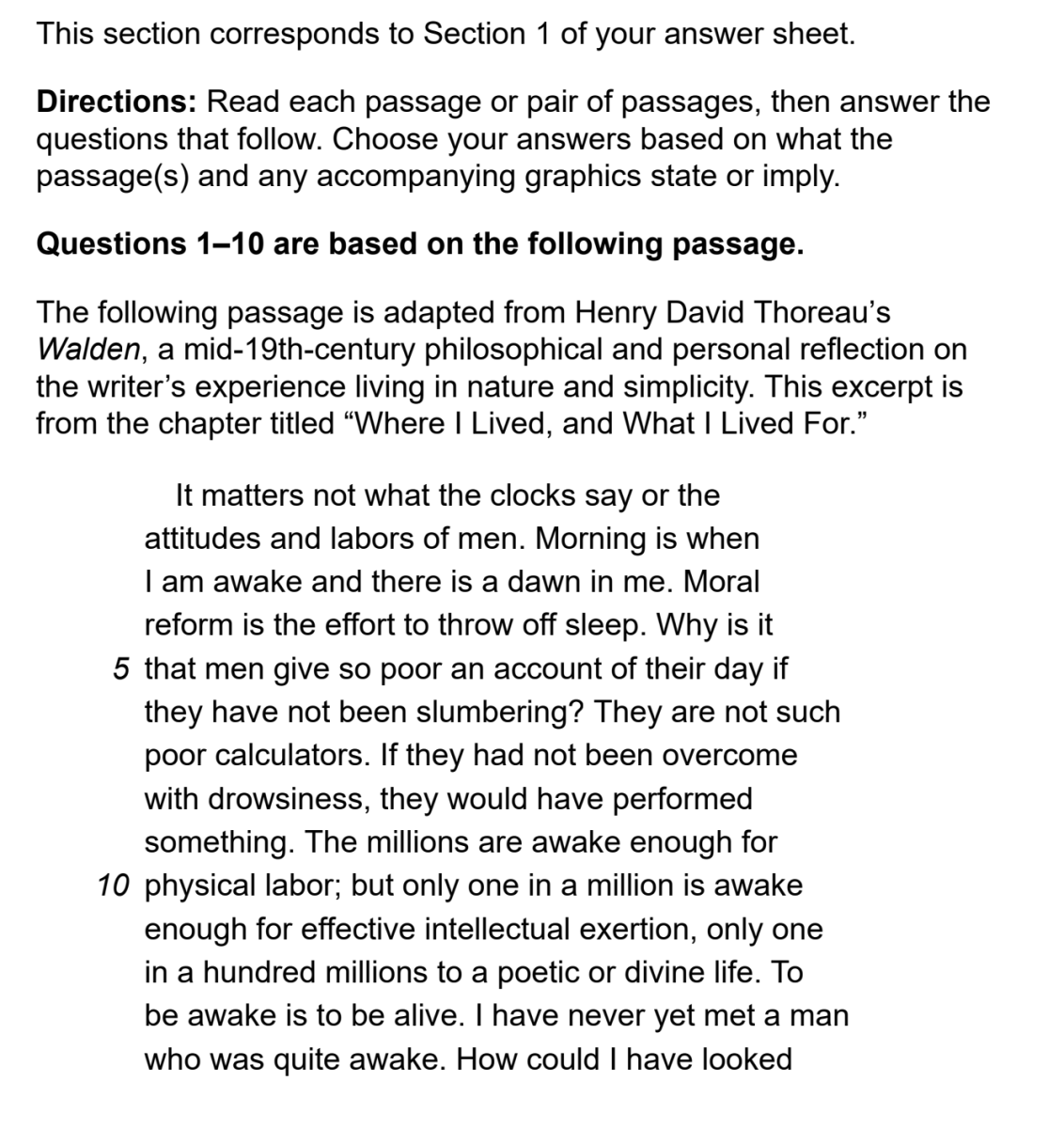
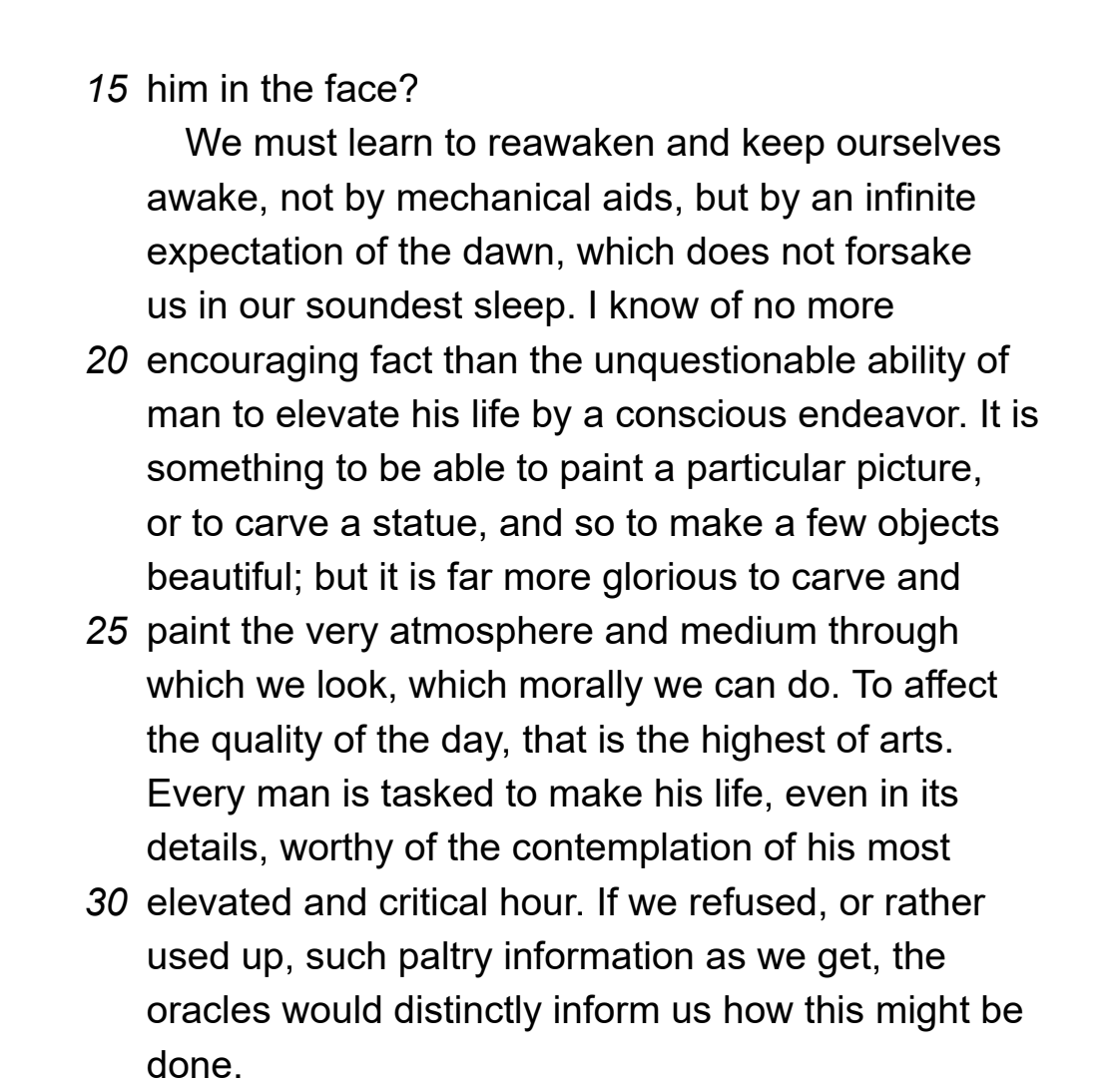
.png)
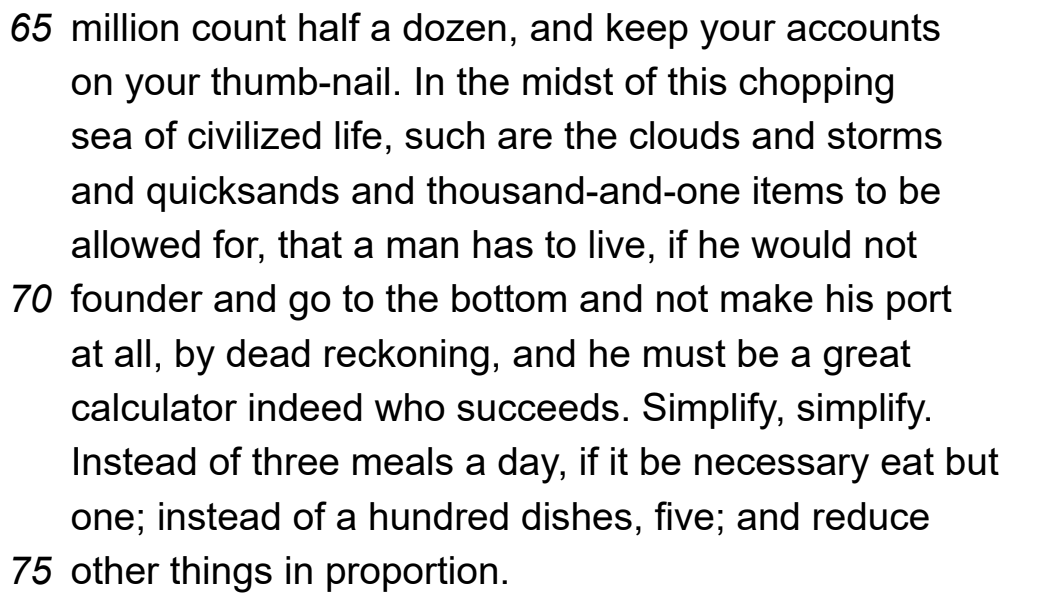
1. The activities described in lines 21–26 (“It is something . . . morally we can do”) explain how people can
A) develop a satisfying and morally upright career.
B) give an elevated and proper account of their day.
C) learn to reawaken and live by conscious endeavor.
D) awaken enough for effective intellectual exhaustion.
2. As used in line 39, “resignation” most nearly means
A) complacency.
B) departure.
C) quitting.
D) revival.
3. The first paragraph of the passage most strongly suggests that which of the following is true of the author?
A) He believes that to affect the quality of the day is the highest form of art.
B) He feels that people perform poorly at work because they sleep too much.
C) He is determined to spend as many waking hours as possible working.
D) He believes that most people have yet to realize their fullest potential in life.
4. Which choice provides the best evidence for the answer to the previous question?
A) Lines 4–6 (“Why is . . . slumbering”)
B) Lines 9–12 (“The millions . . . life”)
C) Lines 12–13 (“To be . . . alive”)
D) Lines 13–14 (“I have . . . awake”)
5. What central claim does the author make about our society as a whole?
A) The few artists in our society do not receive the recognition they deserve.
B) Our society willingly focuses too much on drudgery and insignificant details.
C) Too many people hastily choose to dedicate their lives to religion.
D) People should move to the woods to find their own conscious endeavor.
6. What can reasonably be inferred about the author’s views on religion?
A) He believes too few people critically examine their religious beliefs.
B) He thinks that his studies in the woods will prove that God is sublime.
C) He thinks that meanness and the sublime are the same in nature.
D) He believes that oracles give us clues about how to live a sublime life.
7. Which choice provides the best evidence for the answer to the previous question?
A) Lines 28–30 (“Every man . . . hour”)
B) Lines 34–38 (“I went . . . not lived”)
C) Lines 40–49 (“I wanted . . . excursion”)
D) Lines 49–53 (“‘For most . . . forever’”)
8. As used in line 42, “Spartan-like” most nearly means
A) indulgent.
B) rigid.
C) pioneering.
D) austere.
9. The author uses such words as “meanly” and “wretchedness” in lines 54–59 in order to imply that
A) people are cruel to one another.
B) society will destroy itself in time.
C) many people’s lives are harsh and mundane.
D) negative tendencies ruin our intelligence.
10. Which of the following describes an approach to life that is similar to the one Thoreau promotes in this passage?
A) Taking courses and acquiring books on how to simplify your life
B) Hiring people to help you do your chores so you can live more simply
C) Cleaning out your closet so that you are left with only the most essential items of clothing
D) Traveling to a cabin without cell phone service to get away from life’s complications for a weekend
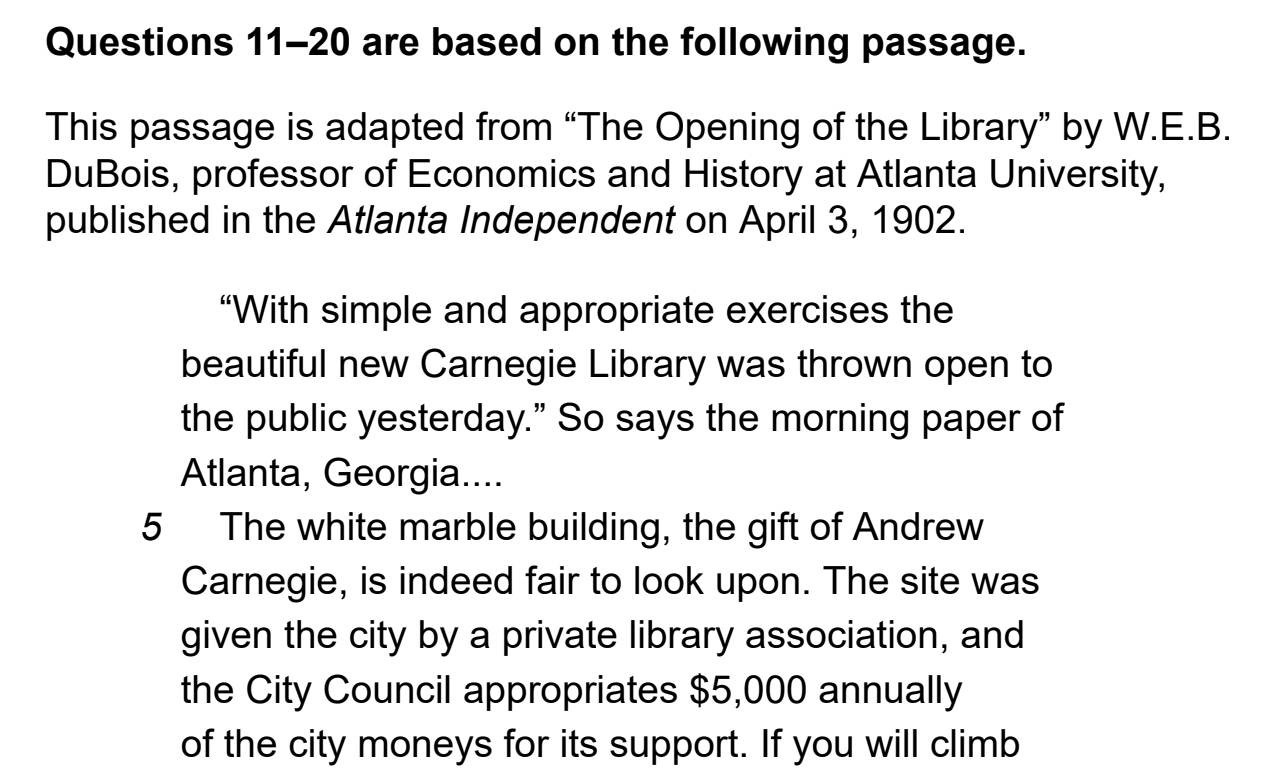
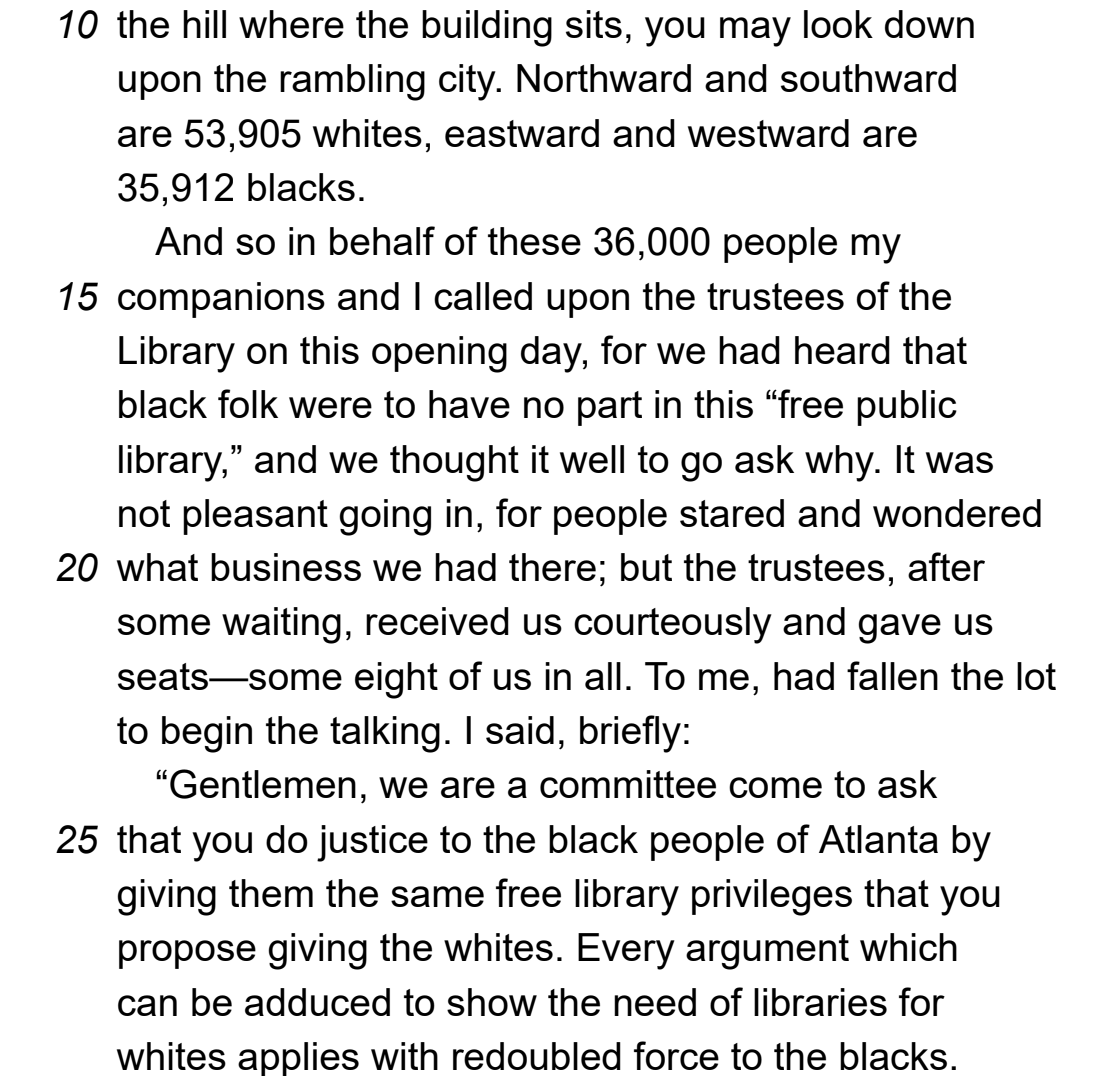
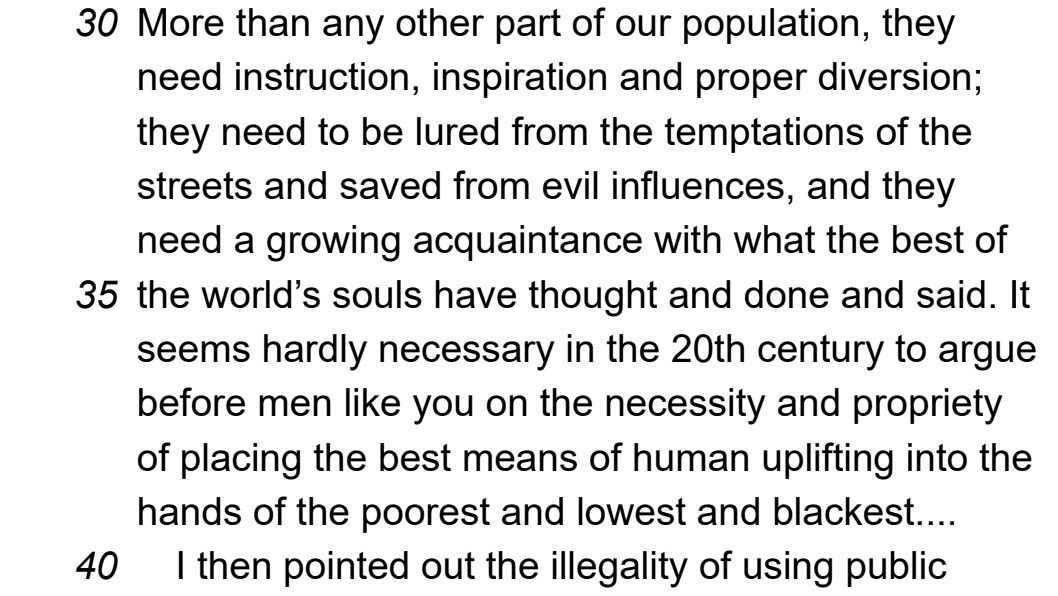
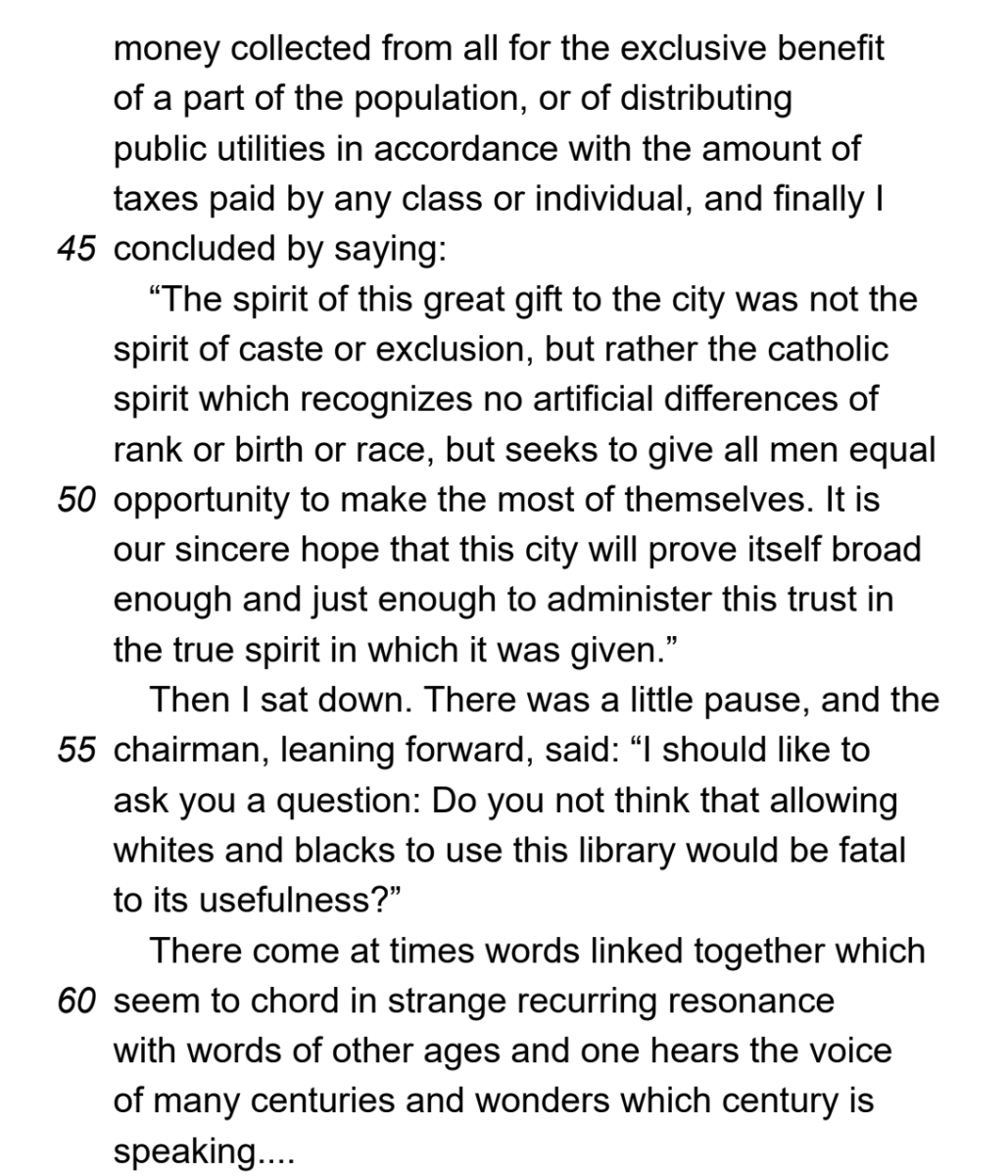
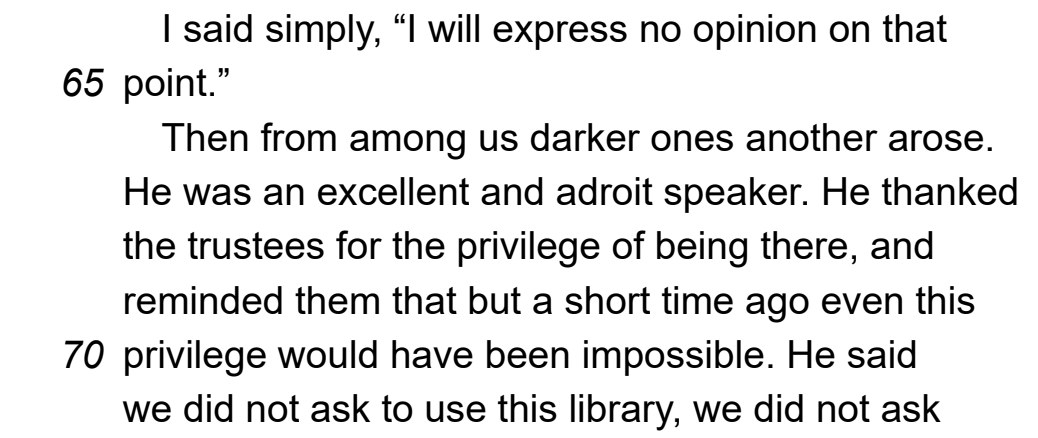
.png)
11. Which choice best explains why DuBois wrote this passage?
A) To encourage philanthropists such as Andrew Carnegie to fund new libraries
B) To present the trustees’ explanation of why African Americans could not use the library
C) To contrast his position on public access to libraries with that of the trustees
D) To state his support for construction of a new library for just African Americans
12. Which choice provides the best evidence for the answer to the previous question?
A) Lines 14–18 (“And so . . . ask why”)
B) Lines 40–44 (“I then . . . or individual”)
C) Lines 67–70 (“He thanked . . . impossible”)
D) Lines 86–91 (“That an effort . . . than the whites”)
13. As used in line 22, “lot” most nearly means
A) a predictable result.
B) a random decision.
C) an unaccepted consequence.
D) an agreed-upon responsibility.
14. It can reasonably be inferred from the passage that
A) the trustees would consider the construction of segregated public library facilities.
B) the trustees agreed with DuBois’s arguments in favor of expanding access to public libraries.
C) the trustees were open to the idea of integrating Atlanta’s public library system.
D) the trustees proposed concrete plans to provide public library facilities for African Americans.
15. Which choice provides the best evidence for the answer to the previous question?
A) Lines 54–58 (“There was a little . . . to its usefulness”)
B) Lines 75–77 (“The president . . . at our call”)
C) Lines 79–80 (“Blacks . . . in Atlanta”)
D) Lines 81–82 (“That some . . . in the future”)
16. As used in line 34, “growing acquaintance” most nearly means
A) a friendly relationship.
B) an increasing comprehension.
C) an active involvement.
D) a brief initiation.
17. Which claim does DuBois make to the trustees?
A) Allowing all of Atlanta’s residents to use the new library would render it useless.
B) Blacks will benefit less from access to public libraries than white residents.
C) Poor blacks have greater need for a public library than other residents.
D) Atlanta should invest in public libraries and schools for all of its residents.
18. DuBois uses the example of a “catholic spirit” (lines 47–48) to support the argument that
A) the city’s neighborhoods continue to be segregated by race and economic class.
B) Atlanta has an obligation to provide equal opportunity for all its residents to better themselves.
C) access to public libraries should be based on the amount of taxes one pays.
D) Northern philanthropists should provide private money to help pay for a public library.
19. The author’s reflections expressed in lines 59–63 most likely indicate that he
A) wishes he lived in a different century.
B) is frustrated that people’s attitudes have not changed over time.
C) is thinking about a time when another person said the exact same words to him.
D) is planning a detailed response to the chairman’s question.
20. The four-point list in the passage can be described as
A) a summary of the author’s supporting points.
B) an acknowledgment of a counterargument.
C) an introduction to a counterargument.
D) a response to the author’s main argument.
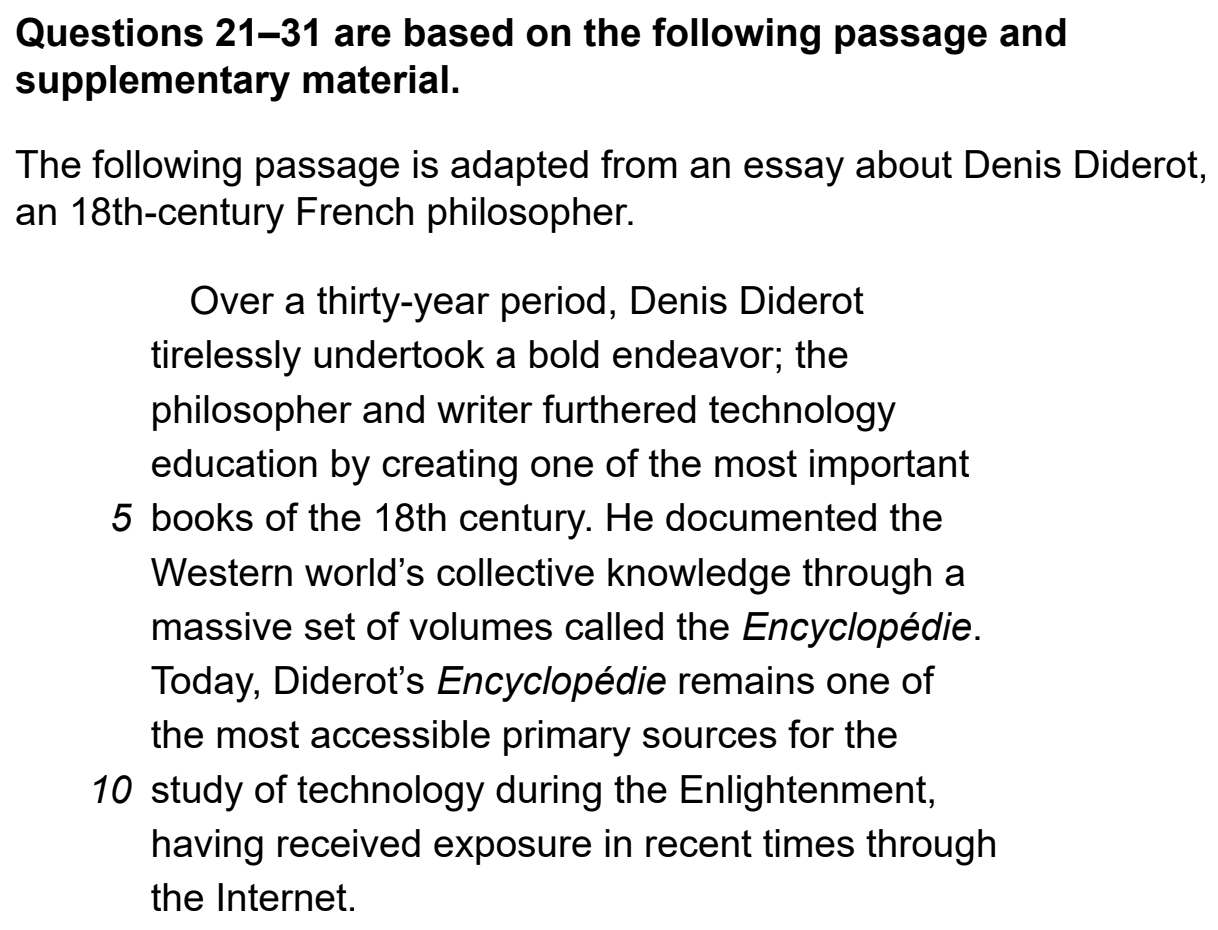
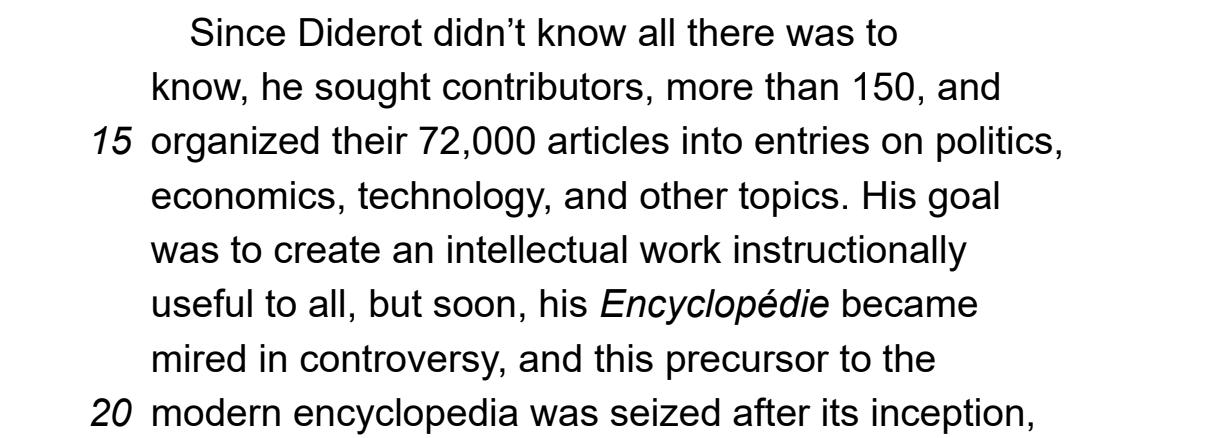
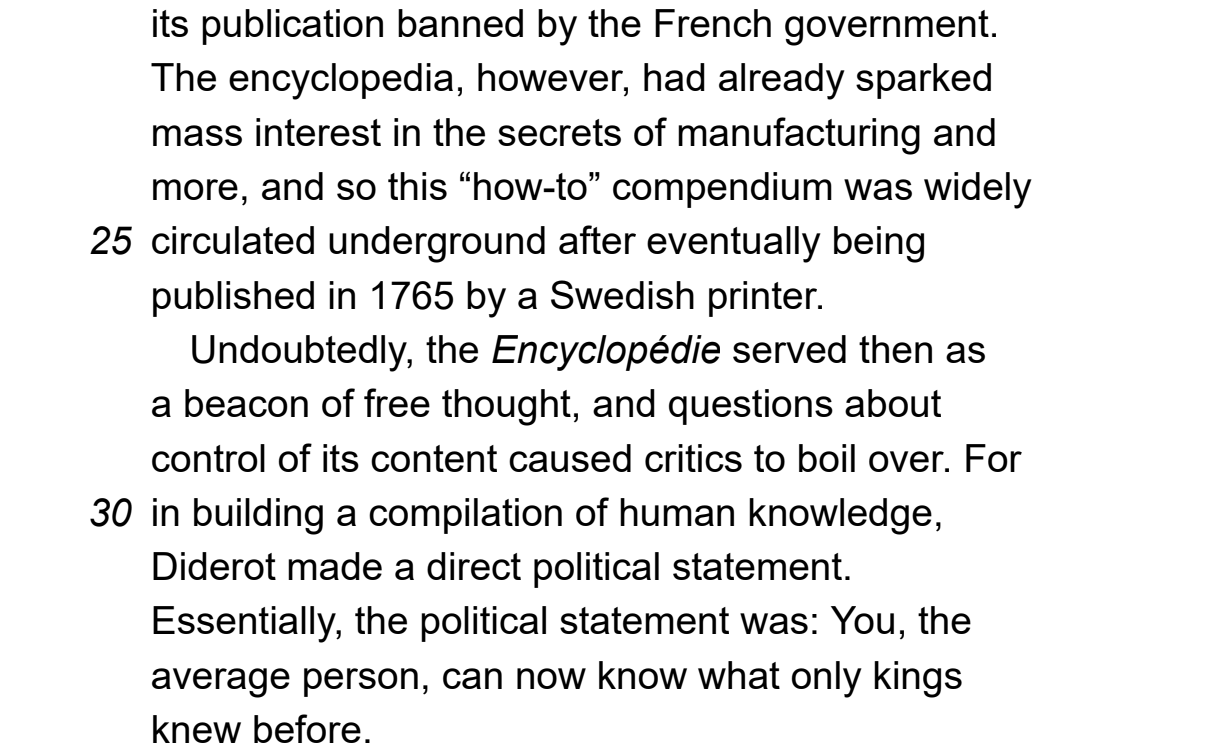
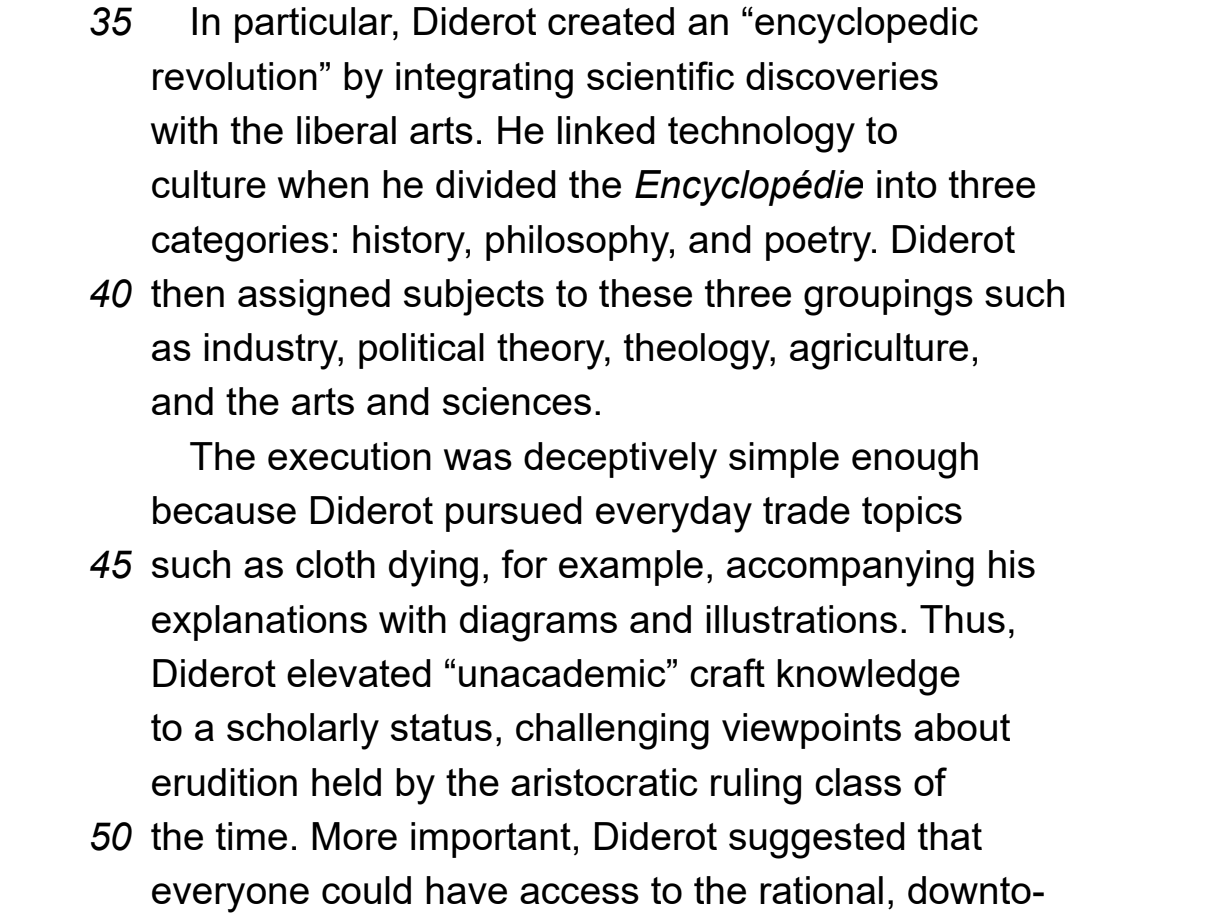
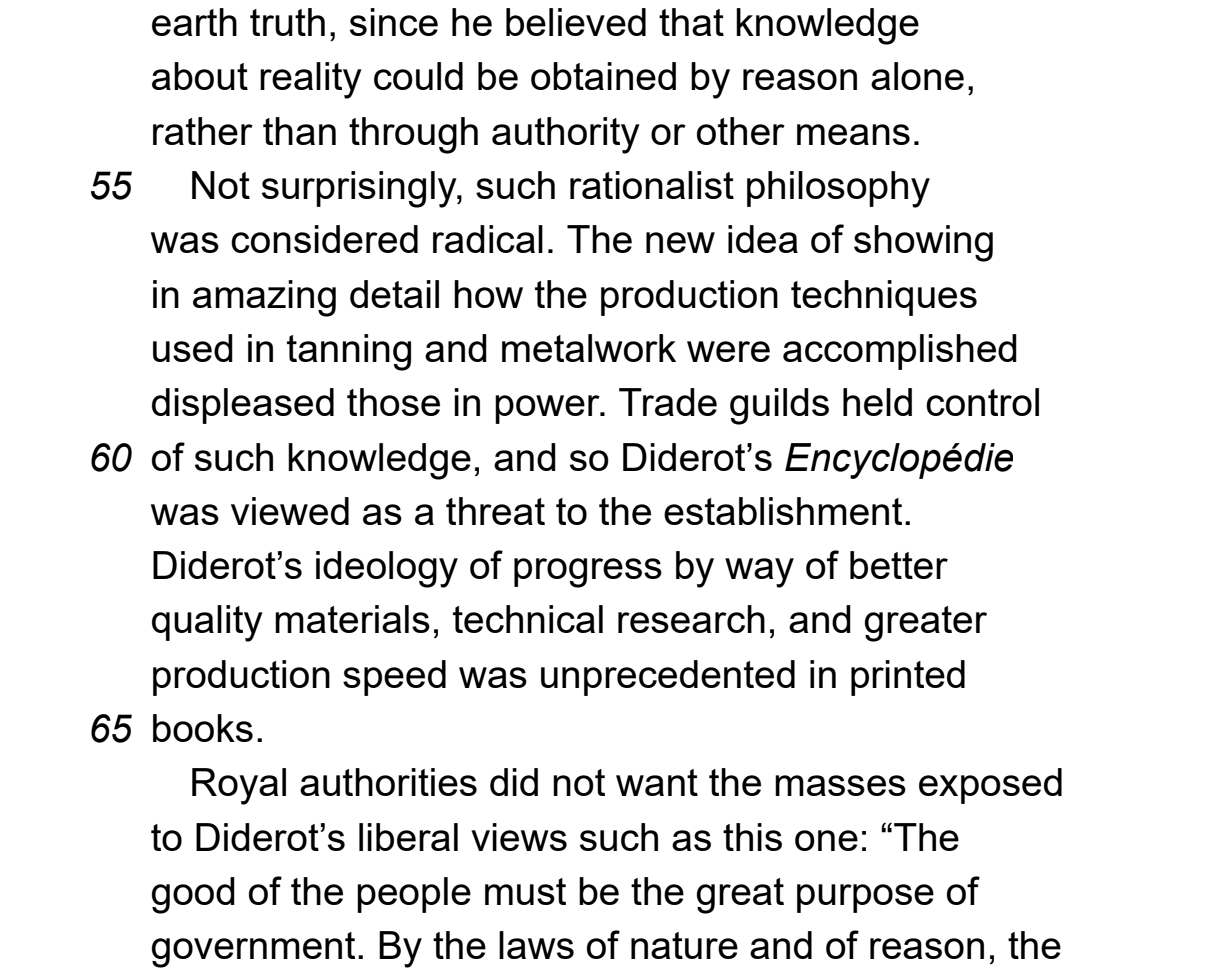
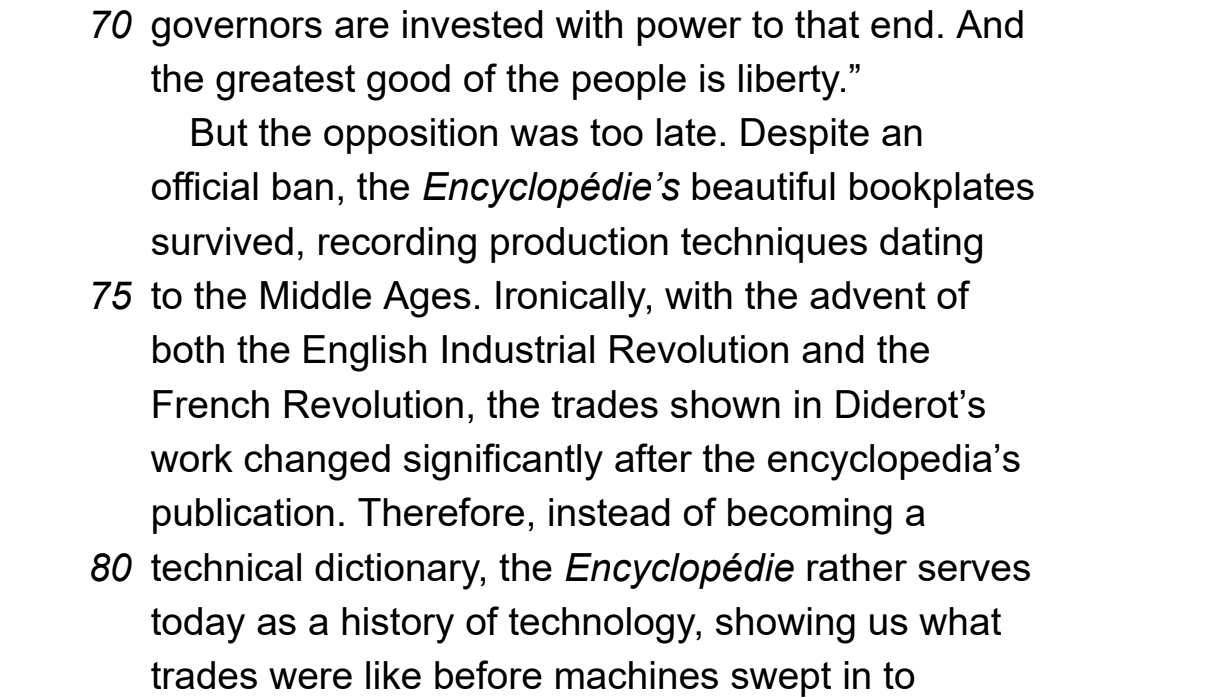
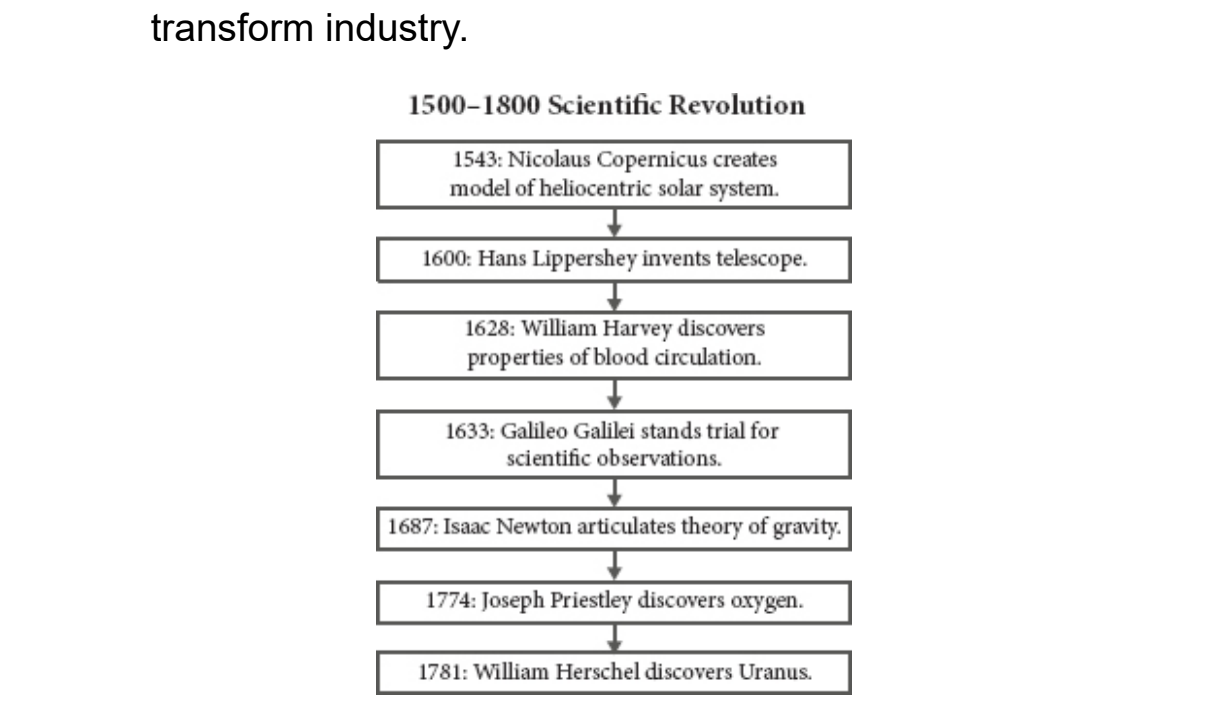
21. Which choice expresses a central idea of the passage?
A) Diderot crafted a revolutionary guide for the development of industrial technology.
B) Diderot provided students with a superb reference for the study of scientific principles.
C) Diderot’s Encyclopédie continues to serve as a valuable technical resource.
D) Diderot’s Encyclopédie helped promote the liberalization and expansion of knowledge.
22. The passage most clearly reflects the author’s
A) devotion to the study of science.
B) disdain for intellectualism.
C) interest in early printing methods.
D) respect for individual innovation.
23. Which choice provides the best evidence for the answer to the previous question?
A) Lines 35–37 (“In particular . . . liberal arts”)
B) Lines 56–59 (“The new idea . . . in power”)
C) Lines 66–69 (“Royal . . . of government”)
D) Lines 75–79 (“Ironically . . . publication”)
24. According to the passage, Diderot’s main goal in developing the Encyclopédie was to
A) express his views.
B) challenge political authority.
C) provide information and instruction.
D) create a historical record of technology.
25. As used in line 25, “underground” most nearly means
A) cautiously.
B) secretly.
C) perilously.
D) privately.
26. In line 28, the function of the phrase “a beacon of free thought” is to suggest that Diderot’s work
A) attracted more people to the pursuit of knowledge.
B) provided information for people most likely to use it.
C) encouraged revolutionary thinking.
D) spread scientific theory among intellectual circles.
27. The passage most strongly suggests that during this time period
A) access to information was limited to select demographics.
B) advances in printing resulted in comparable advances in other fields.
C) demands for political and social reform were severely punished.
D) intellectuals were widely respected and elevated to elite status.
28. Which choice provides the best evidence for the answer to the previous question?
A) Lines 13–16 (“Since Diderot . . . topics”)
B) Lines 43–46 (“The execution . . . illustrations”)
C) Lines 59–61 (“Trade guilds . . . establishment”)
D) Lines 72–75 (“Despite . . . Middle Ages”)
29. As used in line 49, “erudition” most nearly means
A) hierarchy.
B) sophistication.
C) skill.
D) learning.
30. Which choice best describes how the impact of the Encyclopédie changed over time?
A) Advances in science and industry made the Encyclopédie obsolete.
B) Advances in science and industry changed the Encyclopédie from a “how-to” source into a history of technology.
C) Advances in science and industry turned the Encyclopédie into an affordable, mass-produced publication used by millions.
D) Advances in science and industry led to an expansion of the number of Encyclopédie volumes in each set.
31. Based on the passage and the graphic, which of the following is most likely to be true?
A) Diderot would not have included information about Galileo’s scientific observations.
B) Diderot would have included information on the production techniques used to create the first telescope.
C) Diderot would not have included information about the discovery of Uranus.
D) Diderot would have included information about Einstein’s theory of relativity.
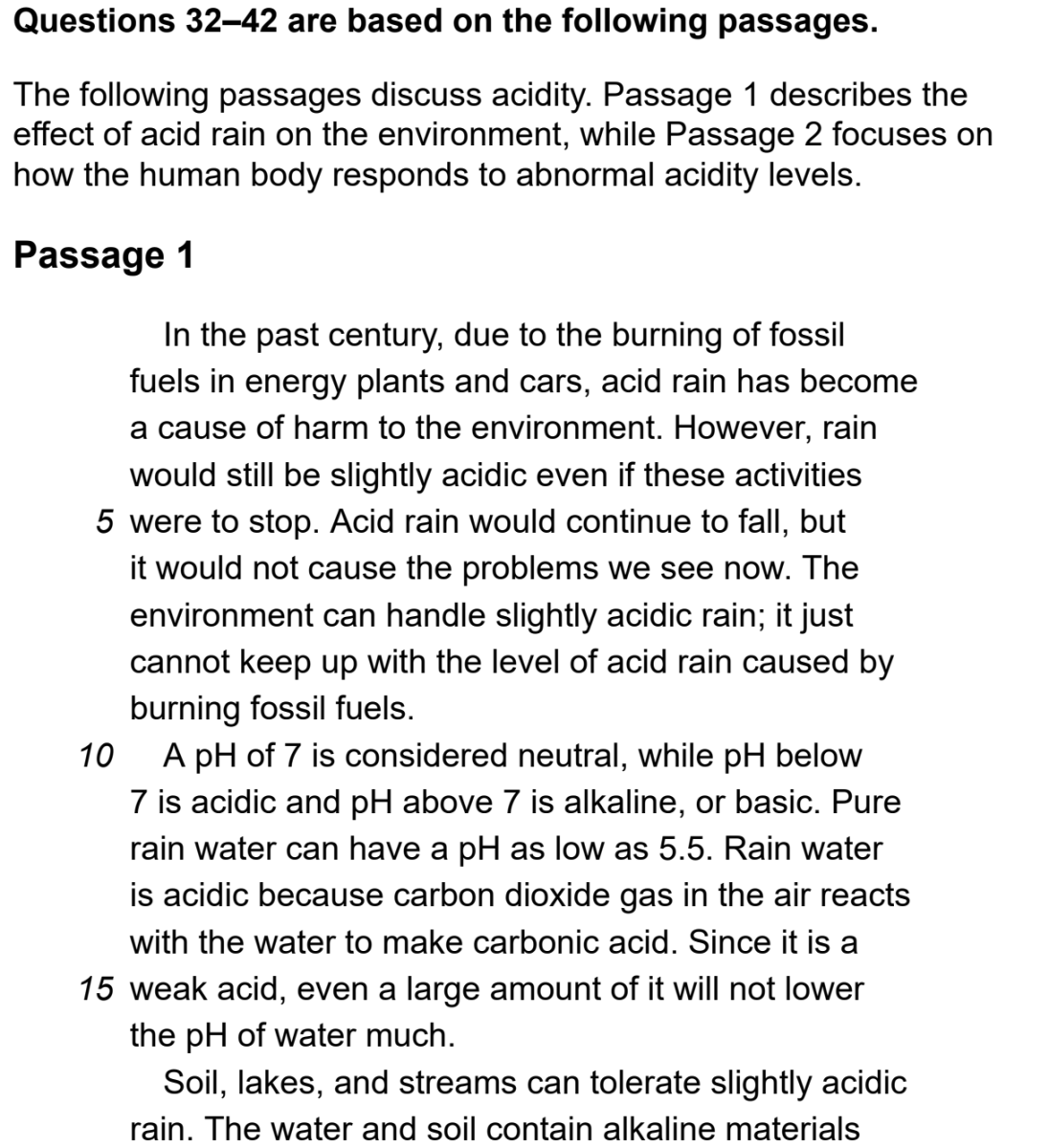
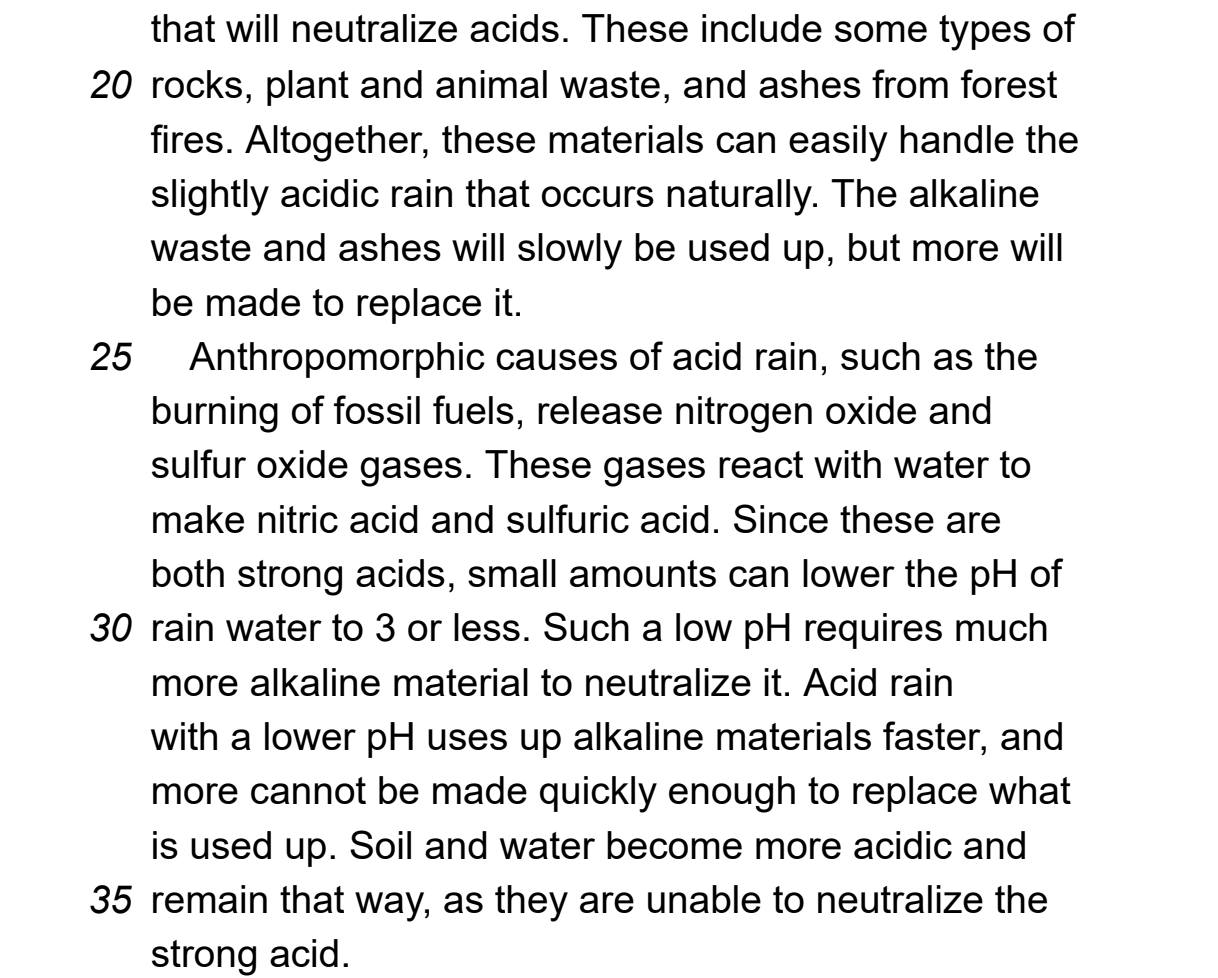
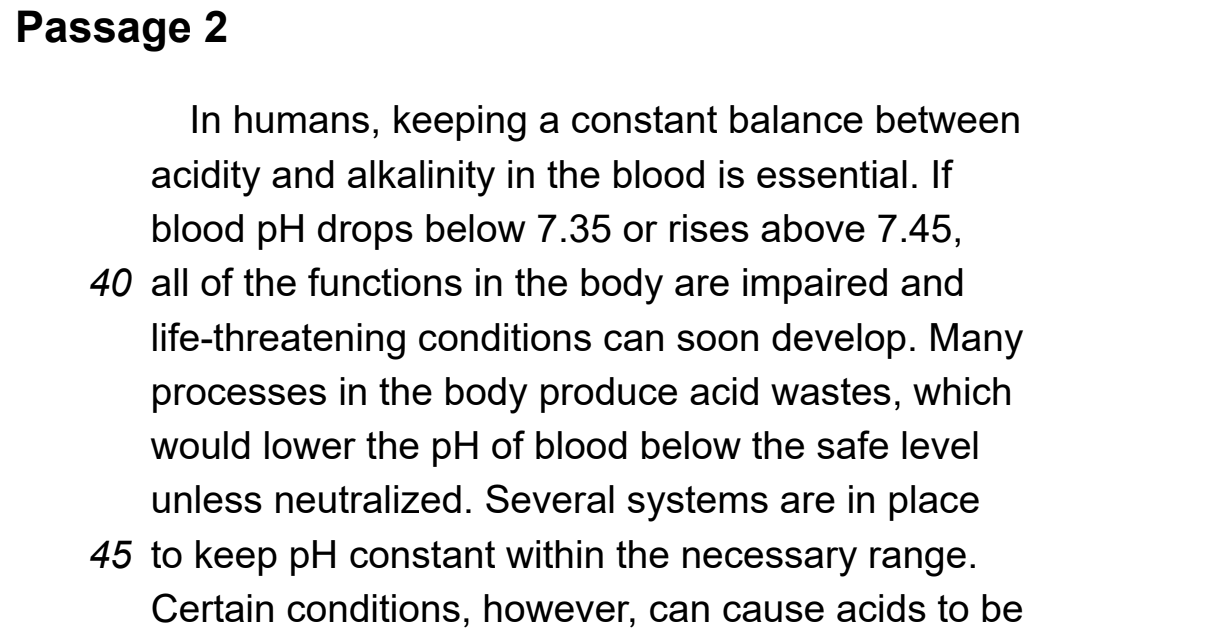
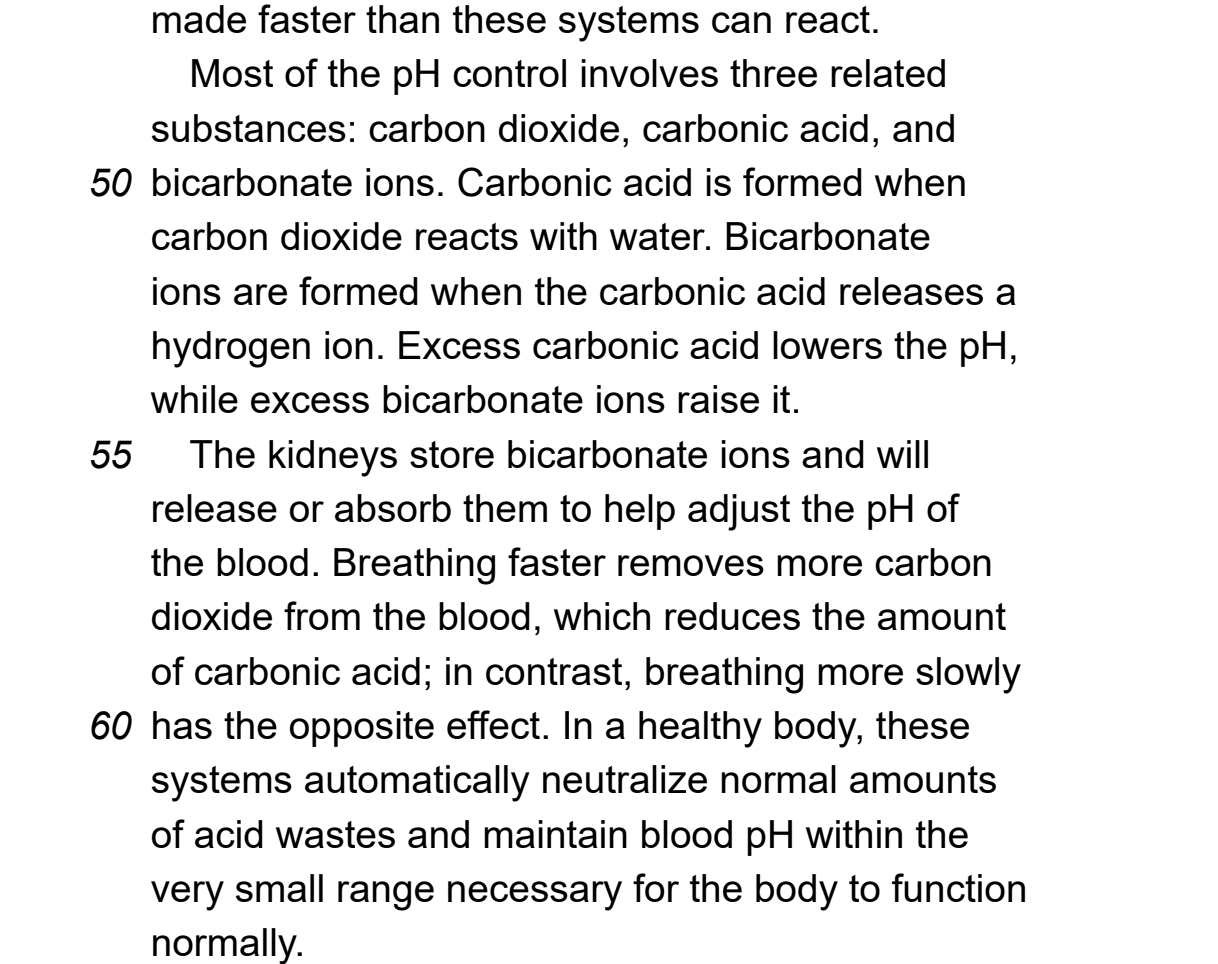
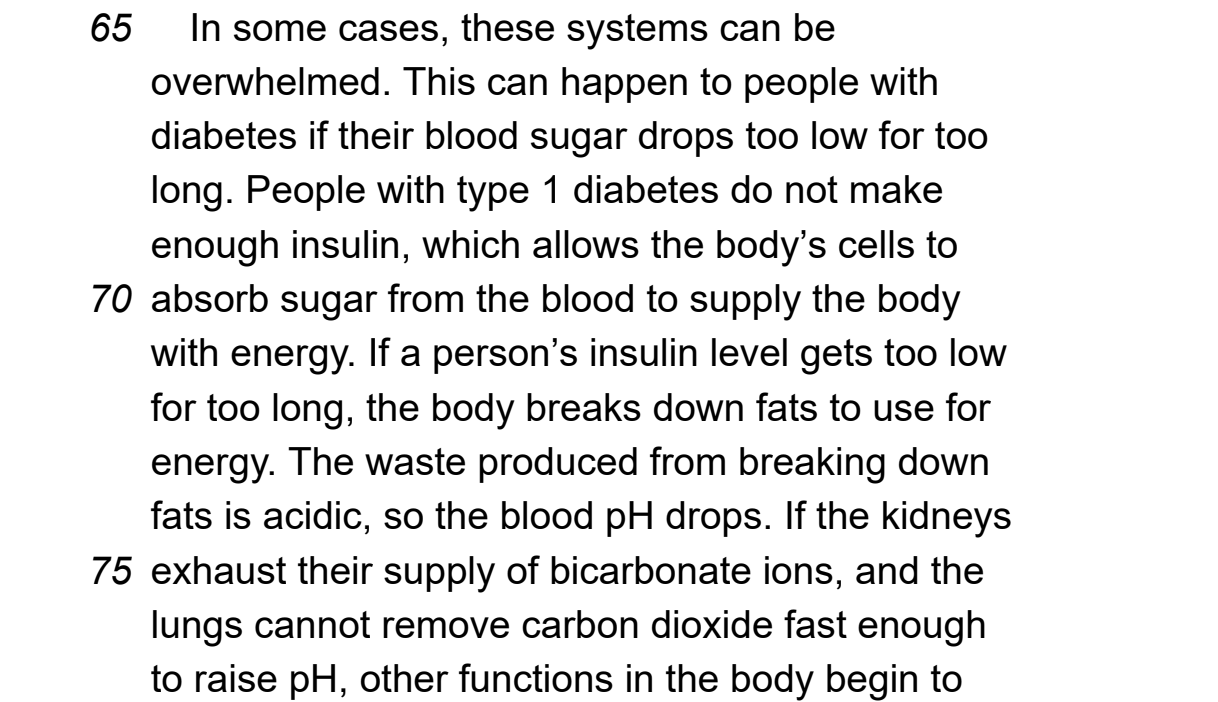

32. Passage 1 most strongly suggests that
A) the environment will be damaged seriously if people do not reduce the burning of fossil fuels.
B) scientists must find a way to introduce more alkaline materials into the water supply to combat acid rain.
C) acid rain will not be a problem in the future as we move away from fossil fuels and toward alternative energy sources.
D) acidic rain water is more of a problem than acidic soil because soil contains more alkaline materials.
33. Which choice provides the best evidence for the answer to the previous question?
A) Lines 6–9 (“The environment . . . fuels”)
B) Lines 12–14 (“Rain water . . . acid”)
C) Lines 17–18 (“Soil, lakes . . . rain”)
D) Lines 25–27 (“Anthropomorphic . . . gases”)
34. According to the information in Passage 1, which pH level for rain water would cause the most damage to the environment?
A) 2.25
B) 4
C) 5
D) 9.1
35. As used in line 17, “tolerate” most nearly means
A) accept.
B) endure.
C) acknowledge.
D) distribute.
36. Passage 2 most strongly suggests that
A) a pH of 7.35 is ideal for blood in the human body.
B) acid wastes in the blood multiply if not neutralized.
C) the normal range of blood pH narrows as a person ages.
D) small amounts of acid wastes in the blood are a normal condition.
37. Which choice provides the best evidence for the answer to the previous question?
A) Lines 38–41 (“If blood pH . . . develop”)
B) Lines 46–47 (“Certain conditions . . . react”)
C) Lines 60–64 (“In a healthy . . . normally”)
D) Lines 68–71 (“People with . . . energy”)
38. As used in line 75, “exhaust” most nearly means
A) fatigue.
B) consume.
C) deplete.
D) dissolve.
39. Which of the following plays a role in the environment most similar to the role played by excess bicarbonate ions in the blood?
A) Acid rain
B) Ashes from a forest fire
C) Sulfur oxide gases
D) Fossil fuels
40. Based on the information in Passage 2, which of the following can cause the body to break down fats to use for energy?
A) An excess of carbonic acid
B) Low blood pH
C) A drop in blood sugar
D) Not enough insulin
41. Which of the following best describes a shared purpose of the authors of both passages?
A) To encourage readers to care for delicate systems such as the environment and human body
B) To explain how the human body neutralizes acid wastes that it produces and deposits in the blood
C) To describe systems that can neutralize small amounts of acids but become overwhelmed by large amounts
D) To persuade readers to work toward reducing acid rain by cutting consumption of fossil fuels
42. Both passages support which of the following generalizations?
A) The human body and environment are delicate systems that require balance to function properly.
B) There are many similarities between the systems that make up the human body and the water cycle.
C) Acid rain is an important issue that will continue to impact the environment until we reduce the use of fossil fuels.
D) Medical treatment is necessary when the pH of a person’s blood drops below 7.35 or rises above 7.45.

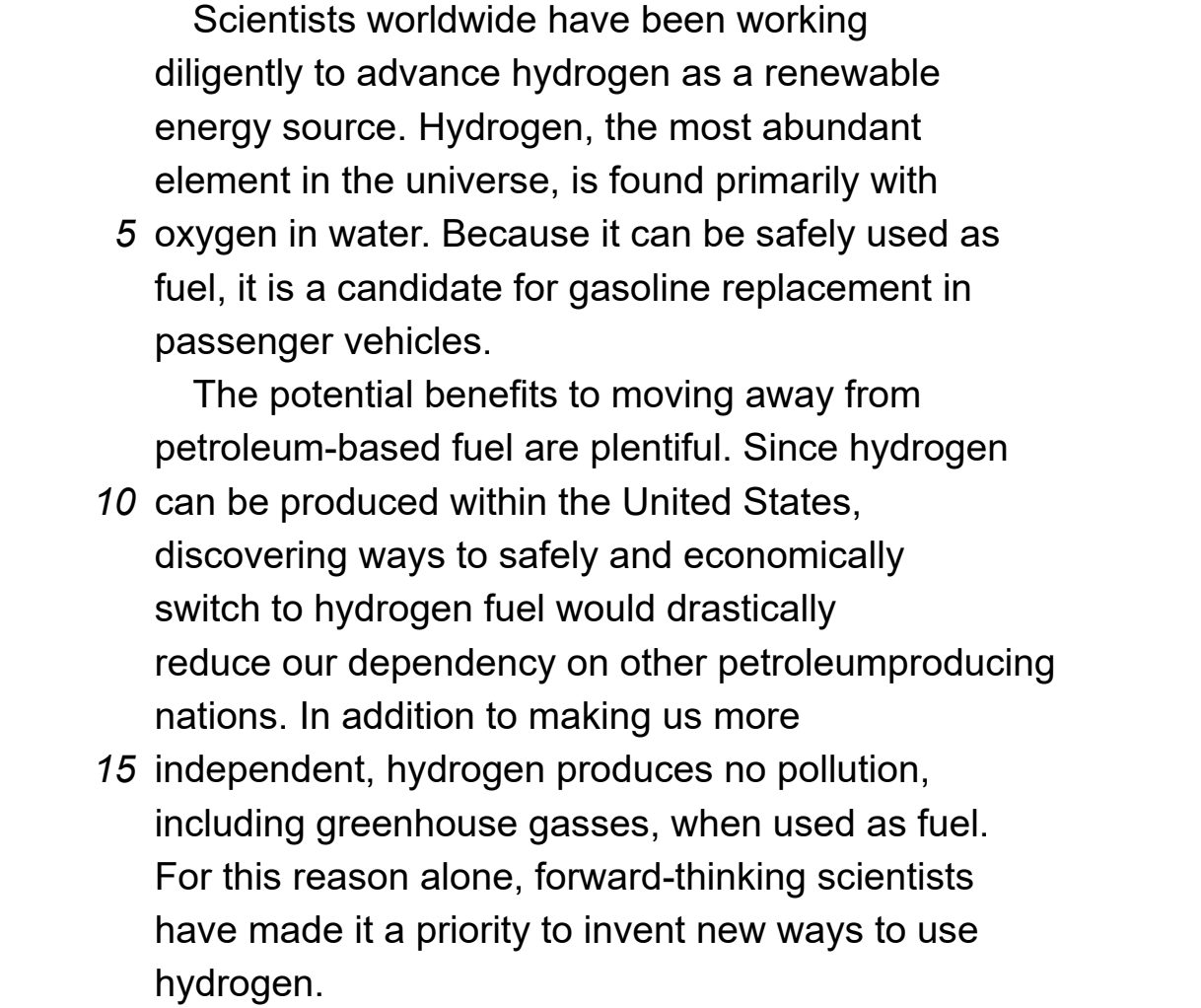
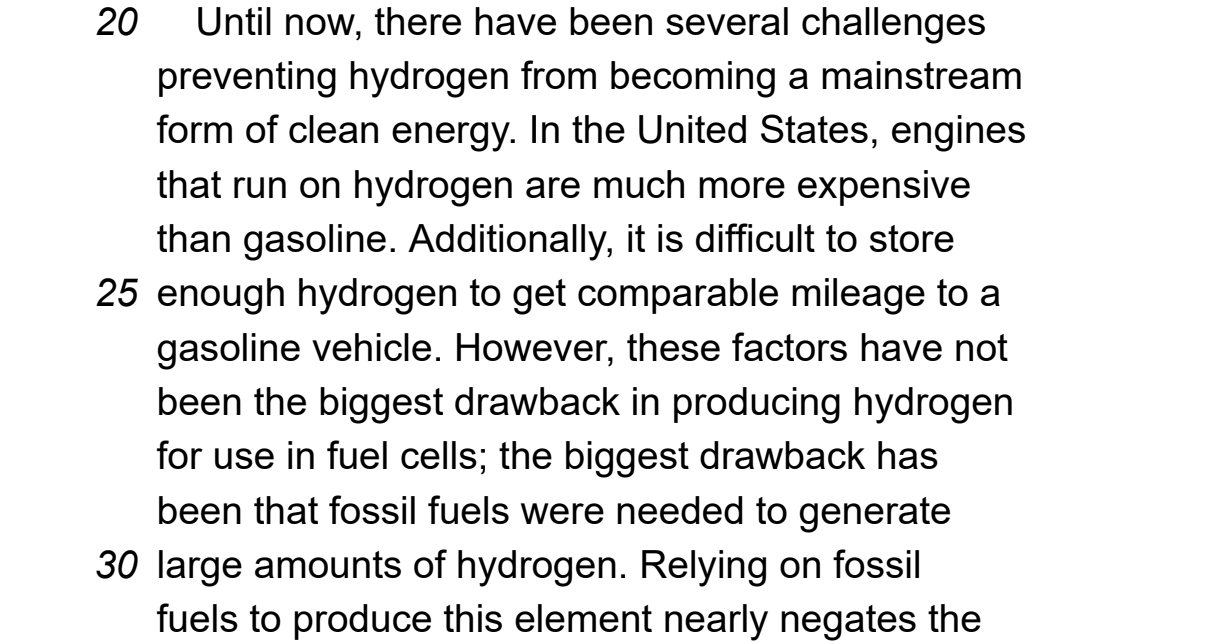
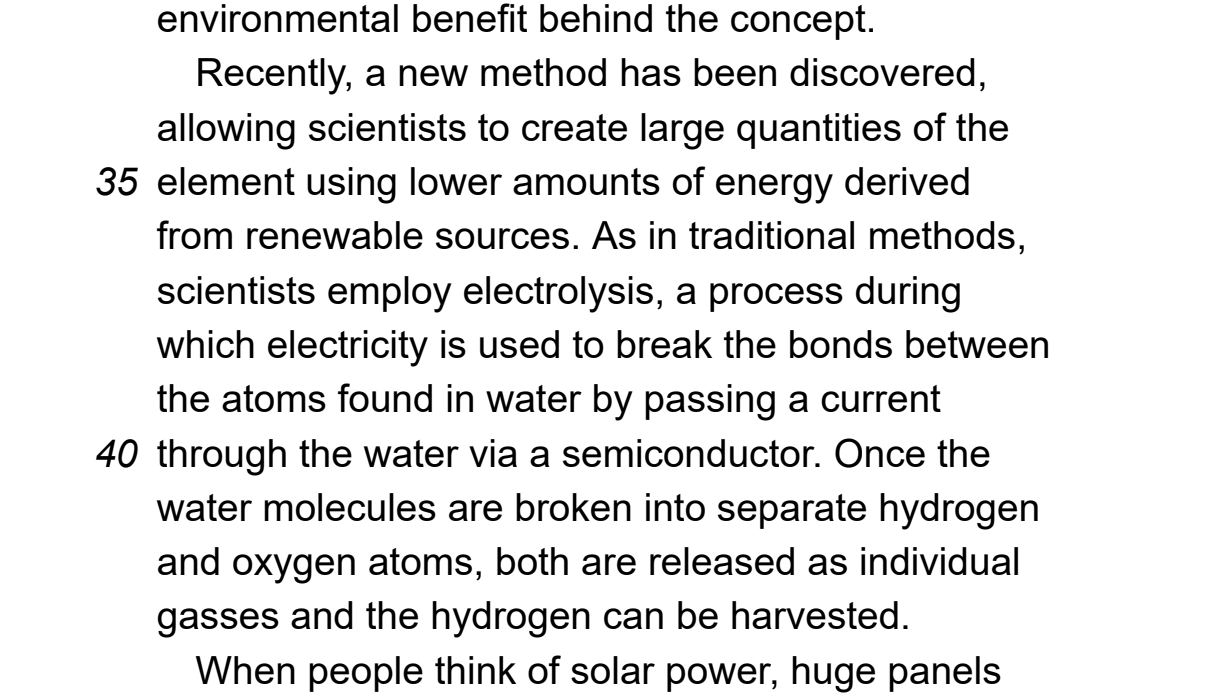
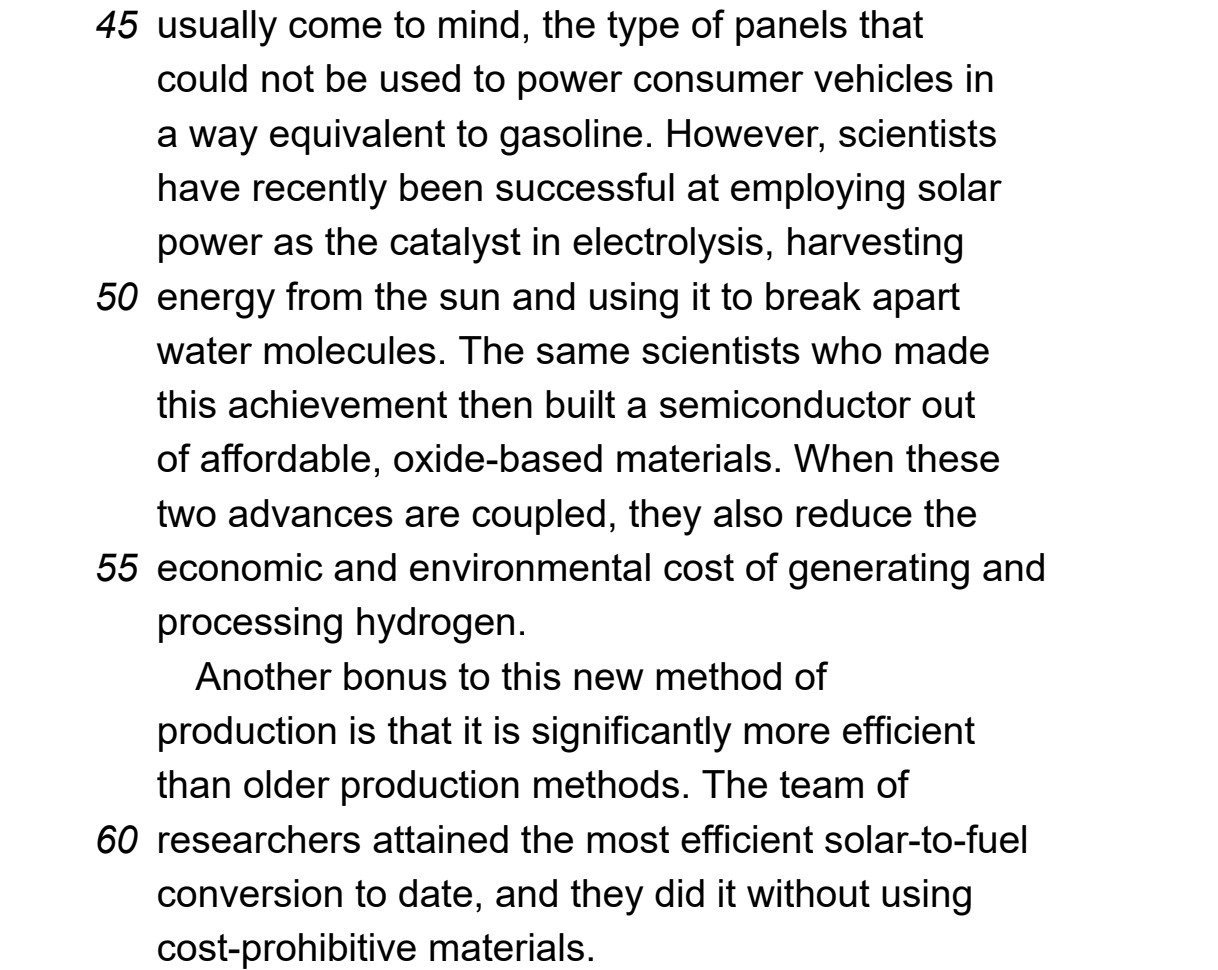
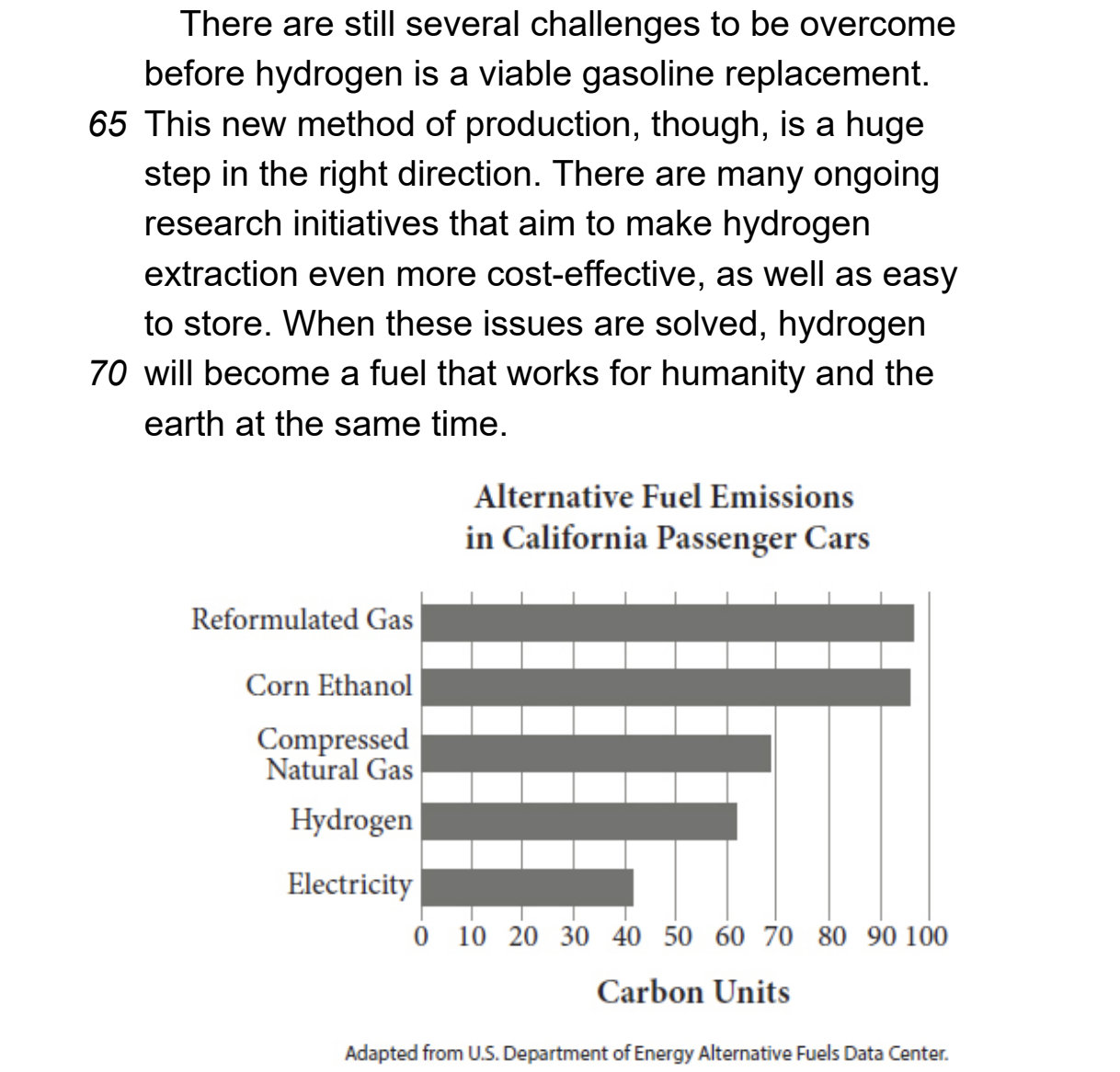
43. With which of the following statements would the author most likely agree?
A) Scientists should consider the final cost to consumers when exploring alternatives to petroleum-based fuels.
B) The development of hydrogen fuel for automobiles will give a boost to the economy in the United States.
C) Safety concerns surrounding hydrogen used as fuel pose the biggest problem for scientists studying alternative energy.
D) Gasoline must be eliminated as a source of fuel for automobiles within the next decade.
44. Which choice provides the best evidence for the answer to the previous question?
A) Lines 5–7 (“Because it . . . vehicles”)
B) Lines 9–14 (“Since hydrogen . . . nations”)
C) Lines 22–24 (“In the United States . . . gasoline”)
D) Lines 53–71 (“When these . . . time”)
45. According to the passage, which of the following is true of hydrogen?
A) It exists mostly with oxygen in water molecules in its natural state.
B) It is more efficient than solar power as an energy source.
C) It can be used as fuel in most types of engines.
D) It can be easily harvested from water molecules.
46. As used in line 2, “diligently” most nearly means
A) impulsively.
B) persistently.
C) rapidly.
D) perpetually.
47. The passage most strongly suggests that which of the following is true of petroleum-based fuel?
A) Its cost is higher than most alternative fuels.
B) Its use has a negative effect on the environment.
C) It cannot be produced in the United States.
D) It is more efficient than other types of fuel.
48. Which choice provides the best evidence for the answer to the previous question?
A) Lines 1–3 (“Scientists . . . source”)
B) Lines 14–16 (“In addition . . . as fuel”)
C) Lines 57–59 (“Another bonus . . . methods”)
D) Lines 59–62 (“The team . . . materials”)
49. In paragraph 2, why does the author explain that hydrogen energy will reduce our dependency on petroleum-producing
nations?
A) To illustrate why scientists in other countries are not working to develop hydrogen energy
B) To highlight how hydrogen energy is superior to other forms of alternative energy
C) To suggest how hydrogen energy can help protect the environment
D) To clarify why the development of hydrogen as a fuel source is important
50. As used in line 35, “derived” most nearly means
A) gained.
B) received.
C) obtained.
D) copied.
51. The passage most strongly suggests that which of the following is true about methods of extracting hydrogen from water?
A) Much additional research is needed to perfect hydrogen extraction.
B) Scientific breakthroughs will soon make hydrogen extraction unnecessary.
C) Scientists are on course to develop a safe way to extract hydrogen within one year.
D) It is unlikely that hydrogen extraction will ever be done in an environmentally friendly way.
52. Information from both the passage and the graphic support the conclusion that
A) compressed natural gas is the most environmentally friendly form of automobile fuel.
B) scientists are making great advances in the development of hydrogen as a fuel for automobiles.
C) electricity produces less air pollution than hydrogen and compressed natural gas.
D) switching from gasoline to hydrogen to fuel automobiles would significantly reduce air pollution.


